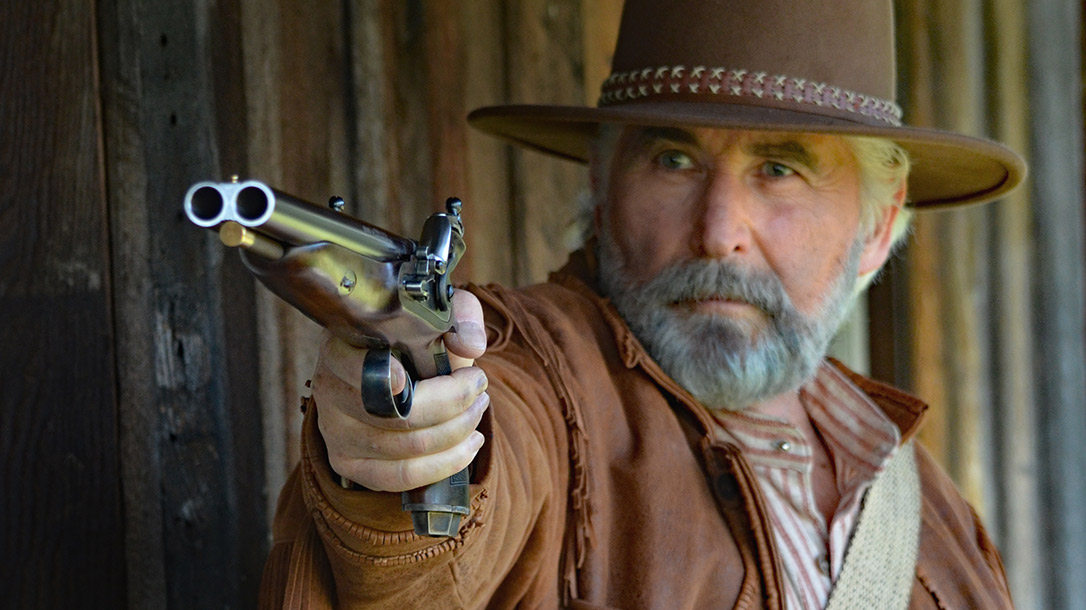Staring down the barrels of a large caliber Howdah double-barrel flintlock pistol can be just as intimidating a sawed-off double-barrel shotgun. And at a glance it is an easy mistake to make.
The Double-barrel flintlock pistol
The double-barreled pistol is a very old design dating back to smoothbore double-barreled wheellock pistols from the 1600s. Flintlock designs, may have been the “inspiration” for sawed-off doubles from the mid to late 19th and early 20th centuries. The latter manufactured in the United States by Ithaca Gun Co. from the early 1920s to mid-1930s as sawed-off shotguns. But reproduced today as a rifled-barrel pistol by Pedersoli and chambered in .45 Colt.
Howdah We Get Here?
The Howdah pistol’s prominence in the 19th century comes from the early double-barreled pistols used in India and Africa. First as percussion (loose powder and ball) side-by-side and superposed pistols, and later as breech-loading large caliber cartridge handguns. Again in both side-by-side and superposed configurations.
Advertisement — Continue Reading Below
On the American Frontier of the 1860s and 1870s, the handful of Howdah-style pistols that made it West were quickly copied by gunsmiths. Also copied by those with little more than a hacksaw and an idea. Thus, as previously mentioned, the possible origin of sawed-off shotguns.
A Howdah pistol, however, is a more elegant sidearm than a shotgun with cut down barrels and stock. The finest modern-day example was the double-barrel percussion 20-gauge and .50-caliber Howdah pistols made by Pedersoli in the last decade.
The Howdah Pistol
The technical description of a Howdah pistol, as outlined by arms historian Robert J. Maze in his 2002 book Howdah to High Power, is that of a “large-caliber (typically rifle-caliber) handgun. Multi-barreled [cartridge-loading] designs were initially favored for Howdah pistols because they offered faster reloading than was possible with contemporary revolvers.”
Advertisement — Continue Reading Below
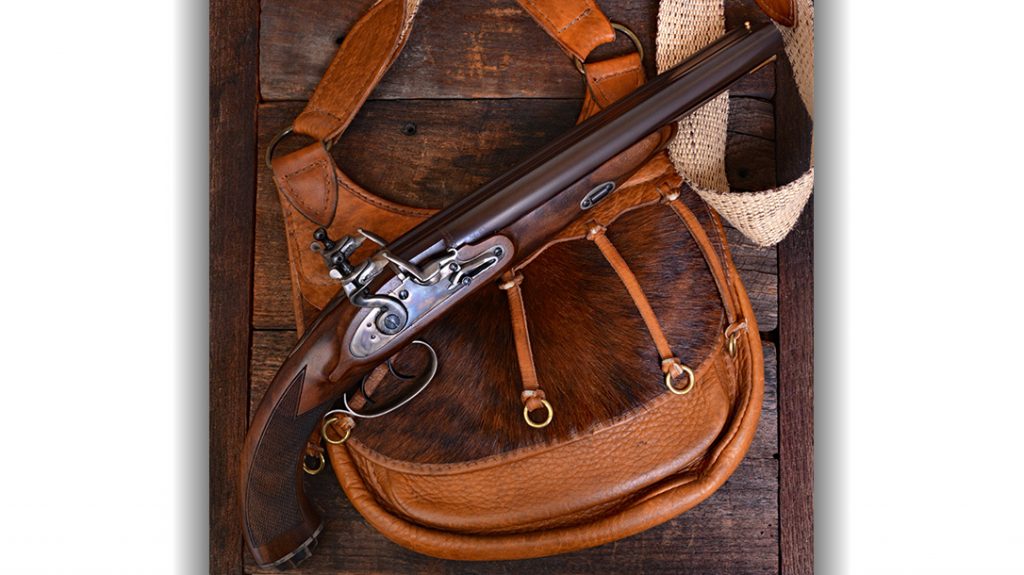
They also offered the advantage of significantly larger calibers than a revolver could provide. The name comes from the big game hunter’s sedan chair or “howdah,” which was attached to the back of elephants. The pistols had their greatest fame during the period of the British Raj in India. They intended for protecting hunters in case a rifle shot did not stop an attacking tiger or other large game animal.
The Howdah pistol was the last line of defense, a large-caliber sidearm designed for close-quarters use. One such gun, an over/under barrel Howdah, figured prominently in the Val Kilmer and Michael Douglas film, The Ghost and the Darkness.
Advertisement — Continue Reading Below
The First Howdah
“The first Howdah pistols were typically in .577 Snider or .577/450 Martini-Henry caliber,” states Maze. However, later on English firearms makers such as Manton & Co. London, and renowned British arms maker Holland & Holland, built specially designed Howdah pistols in both rifle calibers and more conventional handgun calibers such as .455 Webley and .476 Enfield.
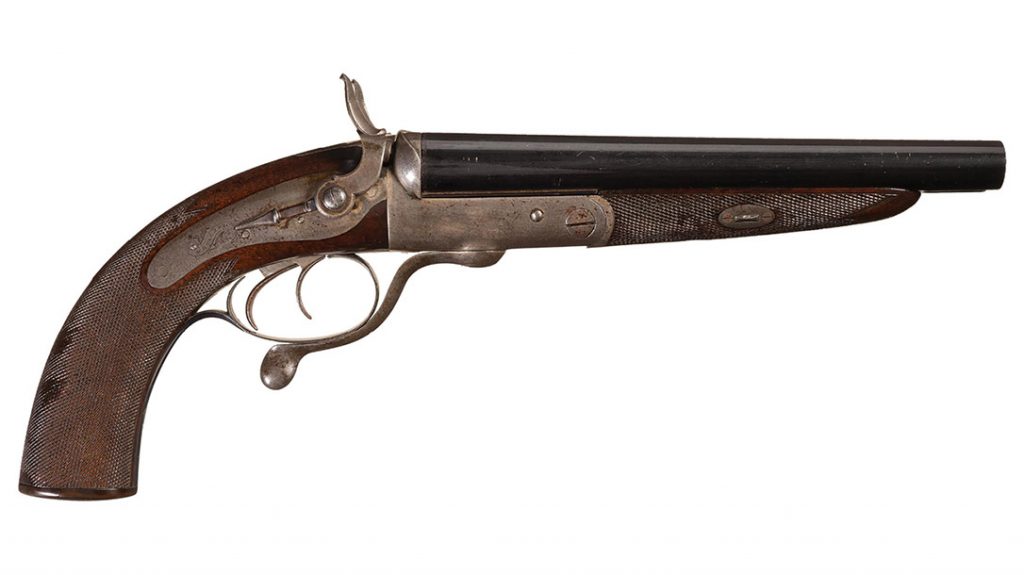
One pair of Howdahs was even chambered in the American pistol caliber .44-40. Howdah is often applied to any number of English, French, Belgian and other European doubles. These include the Lancaster pistol (chambered in calibers from .380 to .577), built in the mid to late 19th century.
Advertisement — Continue Reading Below
Although originally intended for use in only the “gravest extremes” against dangerous game, during the late 1880s Her Majesty’s Royal Army officers adopted them as defensive weapons in the many far-flung outposts of the British Empire.
Flintlock Double
The double-barrel flintlock pistol appeared in Europe during the periods from the mid 1700s to the early 1830s. Percussion lock designs, which vastly improved loading, carrying and accuracy later replaced it. Interestingly, the double-barrel Flintlock pistol’s predecessor, the intricately-built wheellock, was also manufactured as a double-barrel pistol in the mid-1500s.
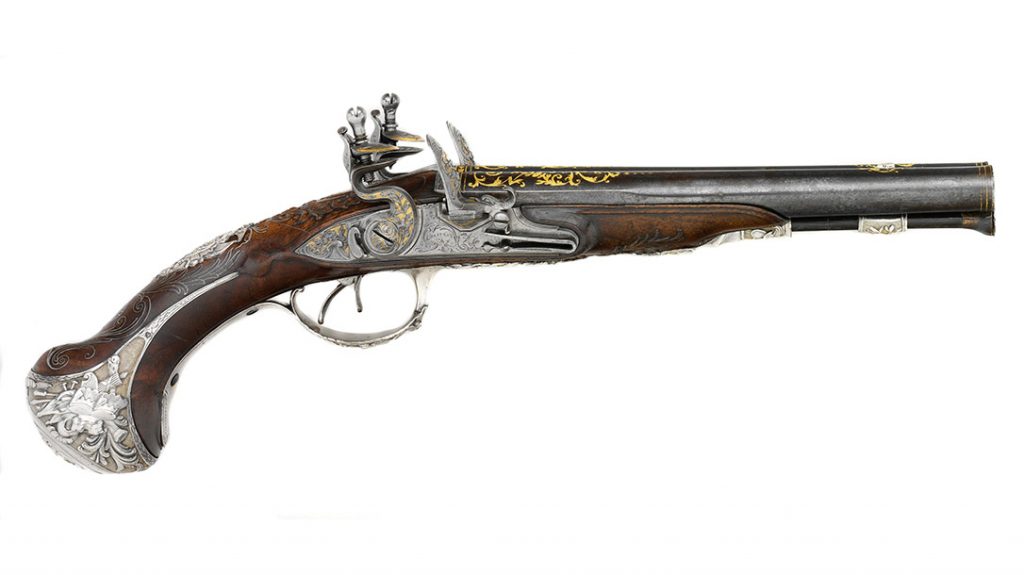
Advertisement — Continue Reading Below
One example in the Metropolitan Museum of Art belonged to Emperor Charles V (1519-1556). So, the double-barrel pistol was far from innovative by the time the first double-barreled pistols (Howdahs) arrived in the 1830s.
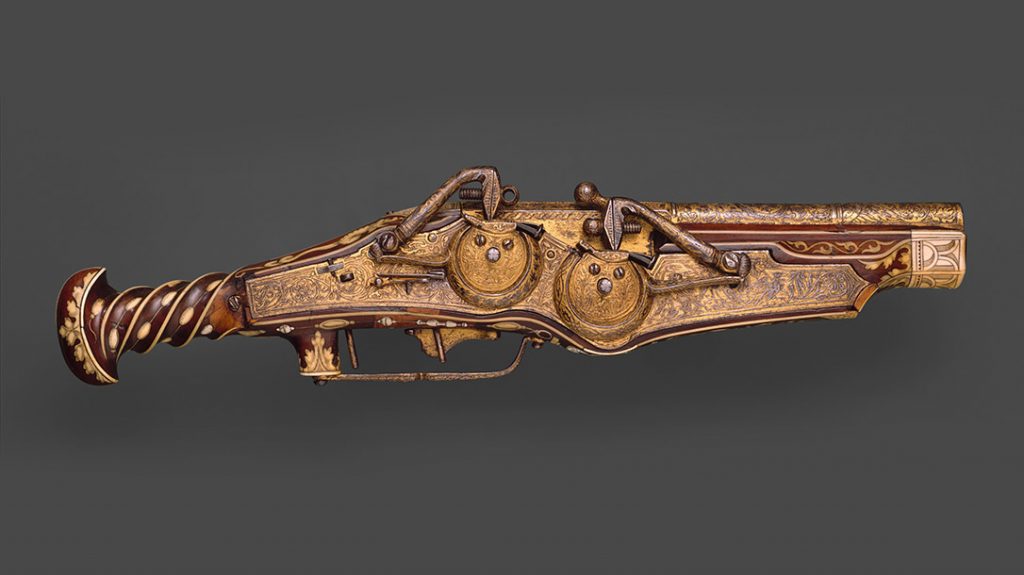
Matchlock
Even the 15th century wheellock muskets had been preceded by a primitive design known as the matchlock. The matchlock dates back to a time when horse-mounted soldiers still wore suits of armor.
Advertisement — Continue Reading Below
The matchlock’s firing mechanism was more akin to a flintlock than the wheellock. Only, here, a slow-burning match, attached to a serpentine lever, ignited the priming powder.
As clever as the matchlock appeared at the time, it was not a particularly reliable weapon. Accuracy with a moving target was sketchy at best. But that would all change in the early 16th century, after the development of the wheellock. It became the first longarm to provide a self-contained system for igniting the priming charge.
The Wheellock
The wheellock was nothing if not remarkably inspired, requiring the mechanical skills of a watchmaker to build. For this reason, it was a costly weapon to produce and more so to purchase. And like winding a timepiece, some degree of forethought was necessary.
Advertisement — Continue Reading Below
The very exacting internal mechanism utilized a cam, spring and small chain as part of the lockwork. It required winding with a key (spanner), which locked the exterior wheel into place. It was necessary to wind the mechanism only in the correct direction, otherwise the gun might be rendered inoperable.
When released by pulling the trigger, the tensioned wheel spun against a piece of iron pyrites held in the jaws of the “dog.” Then, a lever lowered into make ready position over the pan, with the wheel’s serrated edges protruding from below. Releasing the trigger pushed the pan cover forward allowing the edges of the spinning wheel to engage the iron pyrites. Think of it as an old-fashioned Zippo cigarette lighter, creating sparks to ignite the priming charge. It then, like its predecessor, set off the powder in the barrel’s breech.
This is a very simplistic explanation for a very intricate mechanism. One that worked well enough to remain in use for more than a century, even becoming outlawed in some countries.
Advertisement — Continue Reading Below
A Revolution in Firearms Design
Despite its complexity, the wheellock was a revolution in firearms design. For the first time, a weapon could be safely carried, loaded and primed to fire. And there was no telltale burning match to give away a soldier’s position in the dark.
As a military weapon, the wheellock, could hit and, if not kill, most certainly wound an armored soldier on horseback. More significant was that the wheellock mechanism could be used to make pistols as well as longarms. This allowed an individual to be armed with a “practical” handgun for the first time in history.
Yes, matchlock pistols were also made—most notably in Japan and Portugal around the mid-1500s. But “practical” is still the operative word here.
Snaplocks
In the mid-16th century, another, and even more practical design, emerged. The somewhat short-lived “snaphance” or “snap lock.” It was developed in Europe, principally in Germany, Italy, England, France, Scotland and Spain during the mid to late 1500s.
Despite varying opinions among firearms historians, the consensus is that the earliest flintlock muskets came out of Normandy around 1615. Unlike the complicated design of the snaphance, which evolved from the wheellock, the flintlock was more robust, with simpler construction.
The mechanism itself was less intricate, contributing to its longevity and continuous use from the early 17th through mid-19th centuries. Making it the longest of any firearm design in history!
The basic components were the lock plate and pan, the cock (hammer) and jaws (to hold the flint), steel (frizzen) and pan cover, feather spring (for the steel and pan cover), the mainspring, trigger spring, safety catch spring, and the tumbler, combined with the sear and safety catch bolt (to provide full and half cock positions).
Manufacturing
The device was easily manufactured, making the flintlock mechanism suitable to a variety of firearms from long rifles to pistols. Varying calibers and sizes were possible in its construction. It ranged from small-caliber, pocket-sized pistols to hefty 12-gauge and larger fowlers and double guns.
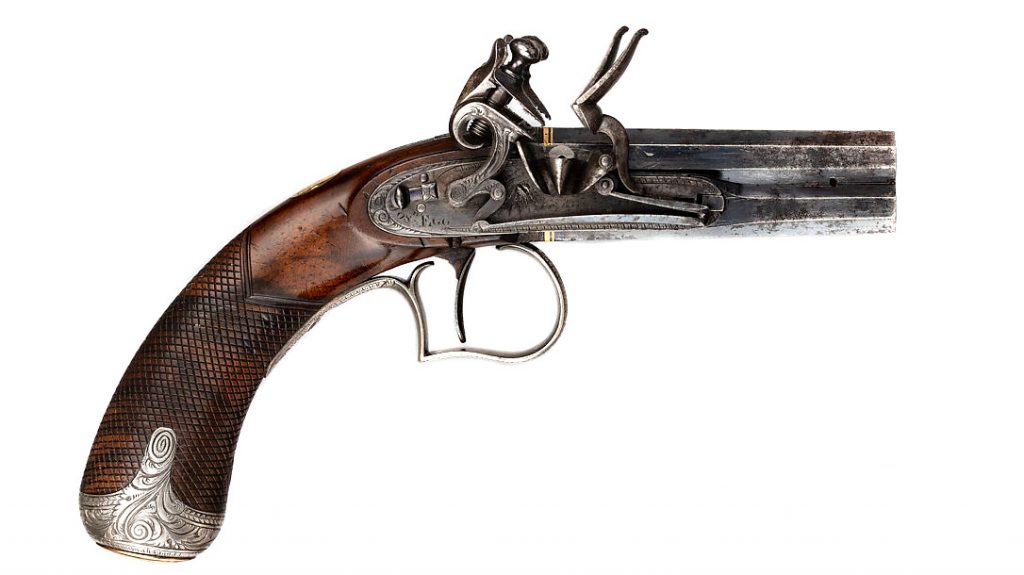
By the early 1700s, the flintlock was the standardized design for muskets, rifles and pistols the world over. During the French and Indian War (1754-1763) and American Revolution (1775-1783), the flintlock became de rigueur throughout much of Europe. This included the whole of the British Empire, particularly in the Colonies.
With the advent of double-barreled flintlock rifles and pistols, the groundwork was in place for pistols with a similar design. This included the basic concept for Howdah pistols, like the new Pedersoli Flintlock, and its recent predecessor, the Pedersoli Double-Barreled Flintlock shotgun, upon which the pistol’s design is based.
Historic Role
Davide Pedersoli has been manufacturing classic European and American flintlock and percussion rifles and pistols for over 60 years. But the development of a double-barreled flintlock shotgun and pistol is rather new for this legendary Italian arms-maker.
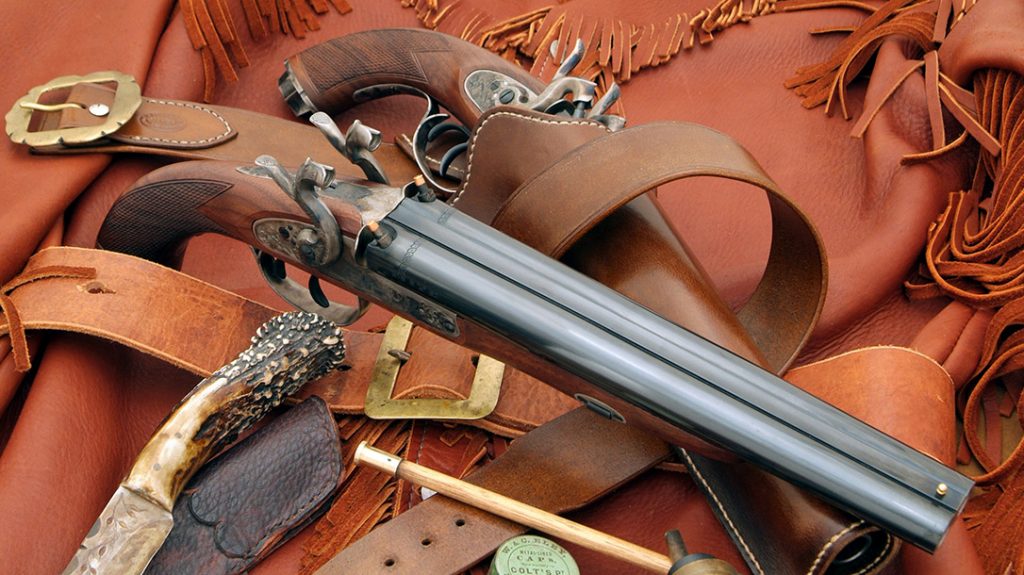
Almost 15 years ago, the author sat down with Pierangelo Pedersoli and began a discussion about European Howdah pistols that dated back to the flintlock and percussion era. At the time, Pierangelo was looking for ways to expand the Pedersoli product line. The line already included some of the most famous European and American single-shot long arms and pistols in history. My suggestion of a 19th century European double-barreled Howdah pistol intrigued him.
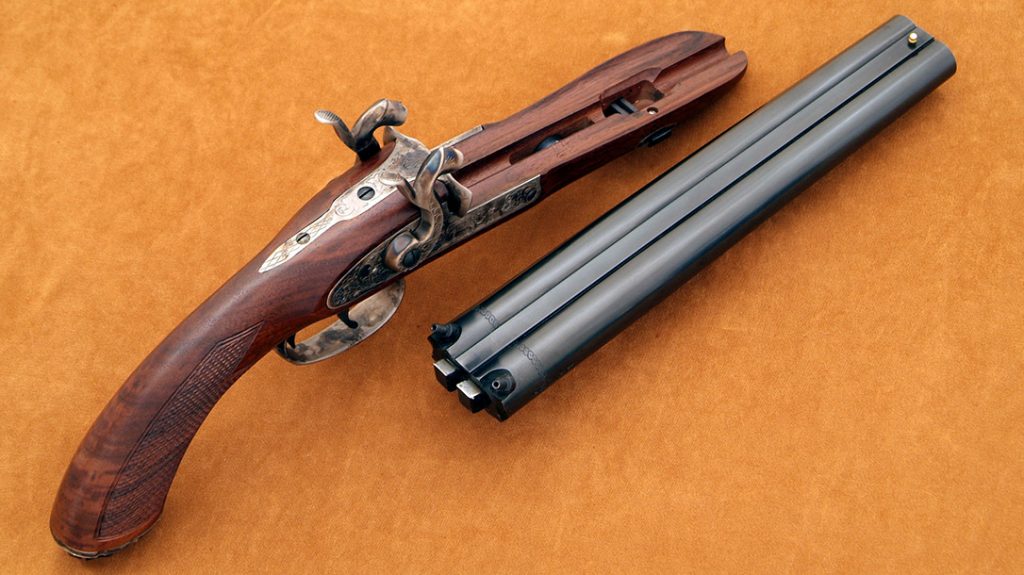
Over the next couple of years, we discussed such designs. Building a left-side pistol lock was the hardest part, even though the company already had the Kodiak Express double rifle. Pierangelo made some prototypes, and in the Fall 2007 the first examples of the Pedersoli Howdah were introduced. The examples were chambered in 20-gauge and .50-caliber Howdah Hunter versions.
Next Steps
A few years later, we discussed the next step (actually, a step back) making a double-barreled flintlock Howdah pistol. Again, the left-side lock was going to be the most difficult part of the design. In the years in between, our discussions led to the development of the rifled barrel .45/.410 Howdah. We based it on the 1920’s Ithaca Auto & Burglar model. That gun released in 2016, and while a giant leap forward in time, we still had to address our old “pet project” flintlock Howdah.
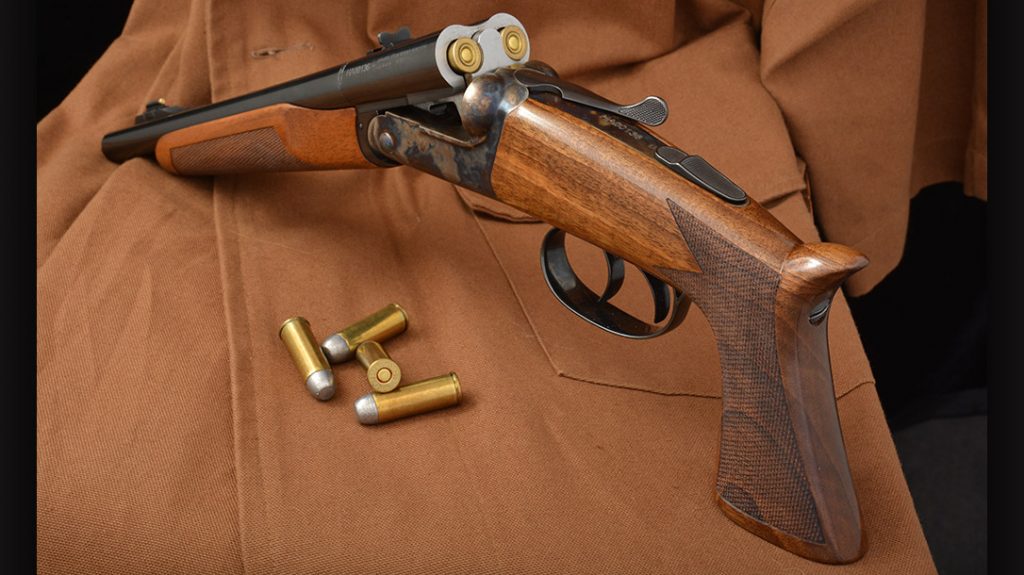
Pierangelo took the most pragmatic approach and developed Davide Pedersoli’s first double-barreled flintlock shotgun. It came just in time for the company to celebrate its 60th anniversary in 2018. You can read more about it in the Fall 2018 issue of Guns of the Old West.
This, French-inspired, 20-gauge double gun came stocked in select oil-finished American walnut with deep checkering on the wrist and forend. It provided a part of the fundamental design for the new Howdah Hunter Flintlock double-barreled pistol, introduced this year.
Pedersoli Howdah Flintlock
The Pedersoli Howdah Flintlock is a classic double-barrel pistol in the English gunsmith school of design. It features double flintlock actions typical of mid-1700’s designs and handsomely color-cased furniture. The stock and barrel design is based on the Howdah Hunter 20-gauge percussion models. It uses a three-quarter stock of European walnut, hand checkered pistol grip and deeply fluted color-cased steel butt cap.
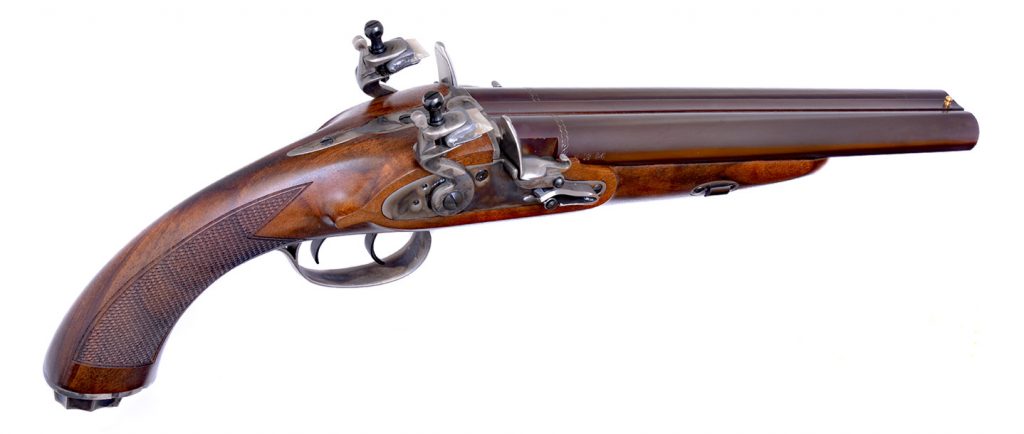
Like the Flintlock double-barrel shotgun, the pistol is also chambered 20 gauge. Following the Howdah percussion model, the front sight is a brass bead as would be found on a shotgun. The nicely browned barrels are the same 11.25 inches in length as the blued percussion model. They are held in place by a single large cross pin.
The overall length is just shy of 18 inches with color casing for the tang and triggerguard. This is a massive pistol. The Howdah Flintlock double weighs in at an impressive 4.9 pounds (about 6 ounces heavier than a Walker Colt). It is not for the weak of wrist (with the mass of the pistol forward of the slim checkered pistol grip) or trigger finger (with average trigger pulls well over 12 pounds).
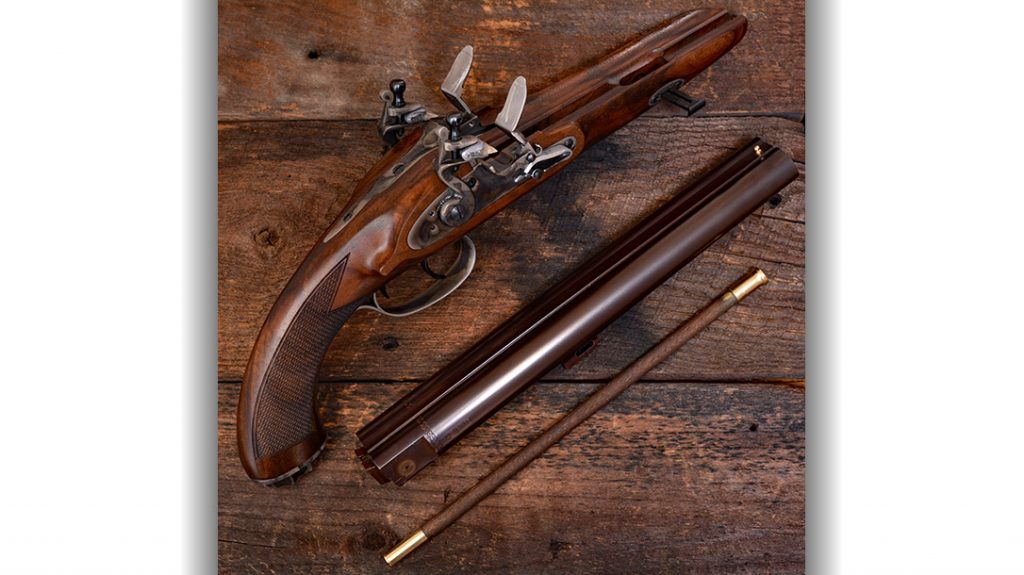
Range Test
Such guns were usually carried in a pommel holster, but a man on foot would have to have carried it tucked behind a belt or in a pouch. I carried it in a belt with the pistol in a cross-draw cant, leaving the curved grip right at hand.
Loaded, you carry the Howdah Flintlock in the half-cock position, making it a little easier to cock. It’s easy to pull the right hammer back on the draw. Or you can roll both hammers back into the cocked position with the palm of your of hand (takes strength). However, it is best to cock each separately when firing; Pedersoli also suggests this..
Fired as a large-caliber pistol, for which it is best suited, the 20×20 Flintlock was loaded with .610 round ball and 0.10 Ox-Yoke Patch, backed by 28 grains of Goex FFg black powder. Pedersoli’s initial recommended load is 28 grains. As I proceeded with the test, I increased the powder charge to 32 grains. I did this because my test of the percussion Howdah had used 35 grains. To prime the pan, I used Goex FFFFg.
Firing the Howdah
For the range test of the Flintlock model, I used a two-handed hold with the support hand under the forearm. I shot at a silhouette target set out at 30 feet. I decided on the closer range over my original 45 feet after test shots proved a bit less accurate.
This is a finicky pistol, as flintlocks can sometimes be, and is prone to fouling after only a few rounds. It’s a good idea to use a nipple pick to ensure the vent hole is open to the powder charge. Given the heavy trigger pull, the gun requires a strong hold to keep it on point of aim (POA).
I found a tendency for the Howdah Flintlock to hit to the left. After a couple of shots, I corrected my aim to the right and 3 inches low. On the silhouette target that was POA at 3 o’clock on the 8-ring to consistently hit a 12 o’clock in the 9-ring, with a best two consecutive shots measuring 1.25 inches at 12 o’clock with one of the pair cutting the 10-ring line.
All my test shots at 30 feet hit in the 9-ring. My best two-shot group measured 1.25 inches.
Final Notes
It will take some fine tuning to get better accuracy. But as a close-quarters defense pistol, the Howdah flintlock delivers its 20-gauge lead ball into center mass with fair consistency. However, swabbing out the barrels, the pan and cleaning the touchhole with the pick after four rounds proved a must with this gun.
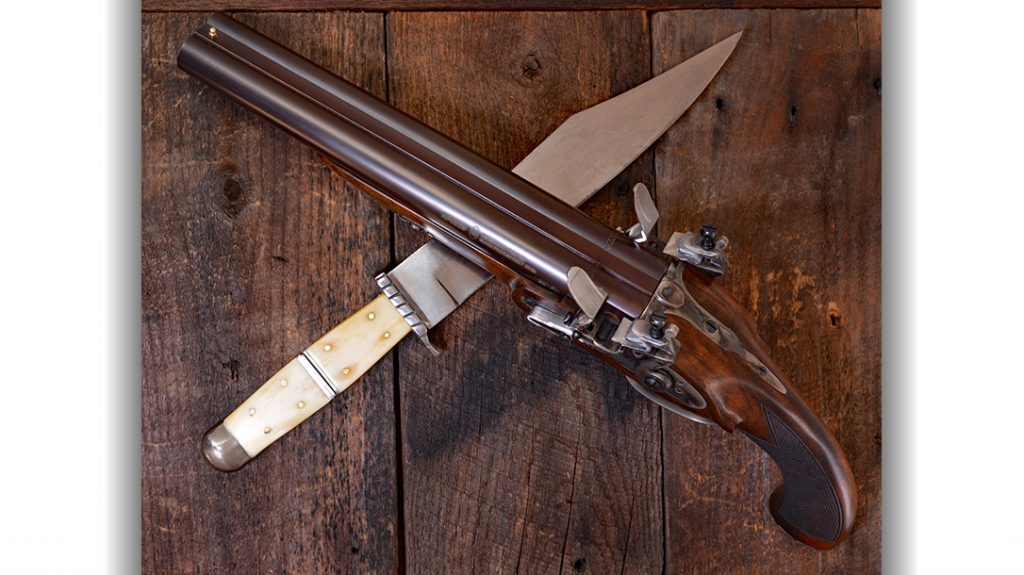
Some longrifle shooters swab their barrel after every shot, so this is not unusual for the double-barrel pistol. Additionally, there are better powder and lube options than I shot, that can reduce fouling. But overall, the Howdah is one great piece of history, executed well by Pedersoli.
In the American West of the 1820s and 1830s, there weren’t any tigers. However, there were many things frontiersmen encountered that were just as deadly. As a sidearm, a Howdah pistol was impressive, offering a quick second shot in a large and effective caliber. And, as it turns out, the new Howdah is a perfect complement to Pedersoli’s 20-gauge double-barreled flintlock shotgun.
For more information, visit italianfirearmsgroup.com.
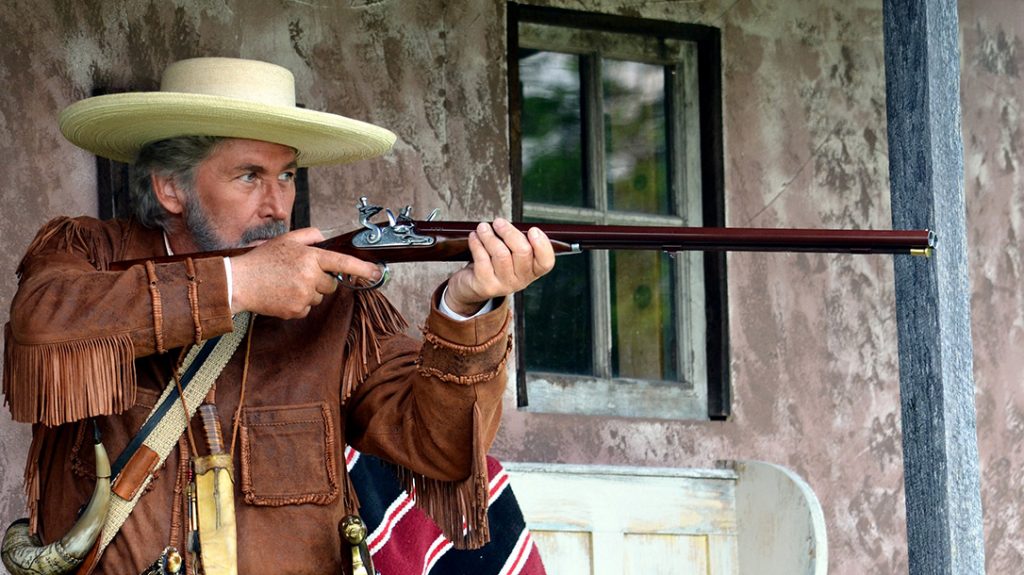
Pedersoli Howdah Double-Barrel Flintlock Pistol Specs
Caliber: 20×20
Barrel: 11.25 inches
OA Length: 18 inches
Weight: 4.9 pounds (empty)
Stock: Walnut
Sights: Brass bead front
Action: Double-hammer flintlock
Finish: Browned barrels, color case hardened steel furniture
Capacity: 2
MSRP: $1,350
This article was originally published in the Guns of the Old West Fall 2021 issue. Subscription is available in print and digital editions at OutdoorGroupStore.com. Or call 1-800-284-5668, or email subscriptions@athlonmediagroup.com.
